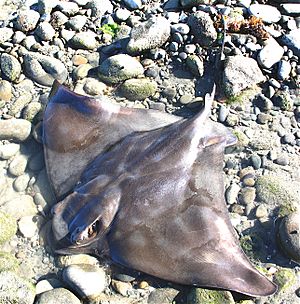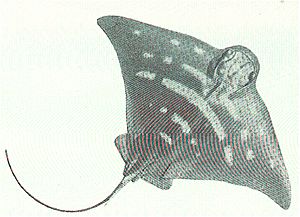New Zealand eagle ray facts for kids
Quick facts for kids New Zealand eagle ray |
|
|---|---|
 |
|
| Conservation status | |
| Scientific classification | |
| Synonyms | |
|
Myliobatis australis |
The New Zealand eagle ray (also known as the Australian eagle ray) is a type of eagle ray. It belongs to the Myliobatidae family. You can find these rays in bays, estuaries, and near rocky reefs. They live around New Zealand and southern Australia, usually in shallow coastal waters. This ray is quite common. The International Union for Conservation of Nature says it is of "least concern", meaning it's not currently in danger of disappearing.
Contents
What the New Zealand Eagle Ray Looks Like
The New Zealand eagle ray is a fish with cartilage instead of bones. It has a body shaped like a flat, round disc. Its head sticks out a bit, looking a little like a frog. It has large, strong fins on its sides that look like wings. These fins move up and down, making the ray seem to "fly" through the water.
This ray also has a long tail. On its tail, there is a spine that can inject venom. Females are usually larger than males. This fish can grow to about 150 centimeters (about 5 feet) wide. Its back is usually olive-green, dark brown, or yellowish, sometimes with grey or pale blue marks. Its belly is white.
Where the New Zealand Eagle Ray Lives
This ray lives in the waters around both the North and South Islands of New Zealand. You can also find it near the Kermadec Islands and Norfolk Island. In Australia, it lives in the southern parts, including Queensland, New South Wales, Victoria, Tasmania, South Australia, and Western Australia.
It usually lives in shallow water, often on sandy flats and in seagrass meadows. It also likes estuaries (where rivers meet the sea), bays, and areas near rocky reefs. While it prefers shallow areas, it has been found as deep as 422 meters (about 1,385 feet).
What the New Zealand Eagle Ray Eats
The New Zealand eagle ray is a type of fish that lives near the bottom of the ocean. It eats small animals without backbones, like clams, oysters, crabs, and worms. It finds these animals on the seabed.
The ray uses its strong teeth to crush its prey. It then spits out any hard bits. It has special organs on its head that can sense electricity. These organs help it find prey hidden completely under sand or mud. Once it finds something, it blows a jet of water out of its gills. This jet uncovers the hidden mollusc or other prey. This process leaves a deep, round pit in the sand. These pits can be as wide as 30 centimeters (about 12 inches) and are often seen in shallow water during summer.
Reproduction and Life Cycle
New Zealand eagle rays give birth to live young. They don't lay eggs that hatch outside their body. A mother ray can have between two and twenty babies at a time. On average, they have about six young.
Before they are born, the baby rays feed on egg yolks inside the mother. Later, they get food from the mother's uterus. When they are born, the young rays are usually about 20 to 30 centimeters (about 8 to 12 inches) across their disc-shaped body.
Conservation Status
The New Zealand eagle ray is a common species. Sometimes, it gets caught by accident in fishing nets. This is called "bycatch". Most of the time, these rays are put back into the ocean. They seem to recover well after being released. Overall, the number of these rays is quite stable.
Because of this, the International Union for the Conservation of Nature says the New Zealand eagle ray is of "least concern". This means it is not currently at risk of becoming endangered. In June 2018, the New Zealand Department of Conservation also said the New Zealand eagle ray is "Not Threatened."
See also
 In Spanish: Myliobatis tenuicaudatus para niños
In Spanish: Myliobatis tenuicaudatus para niños



